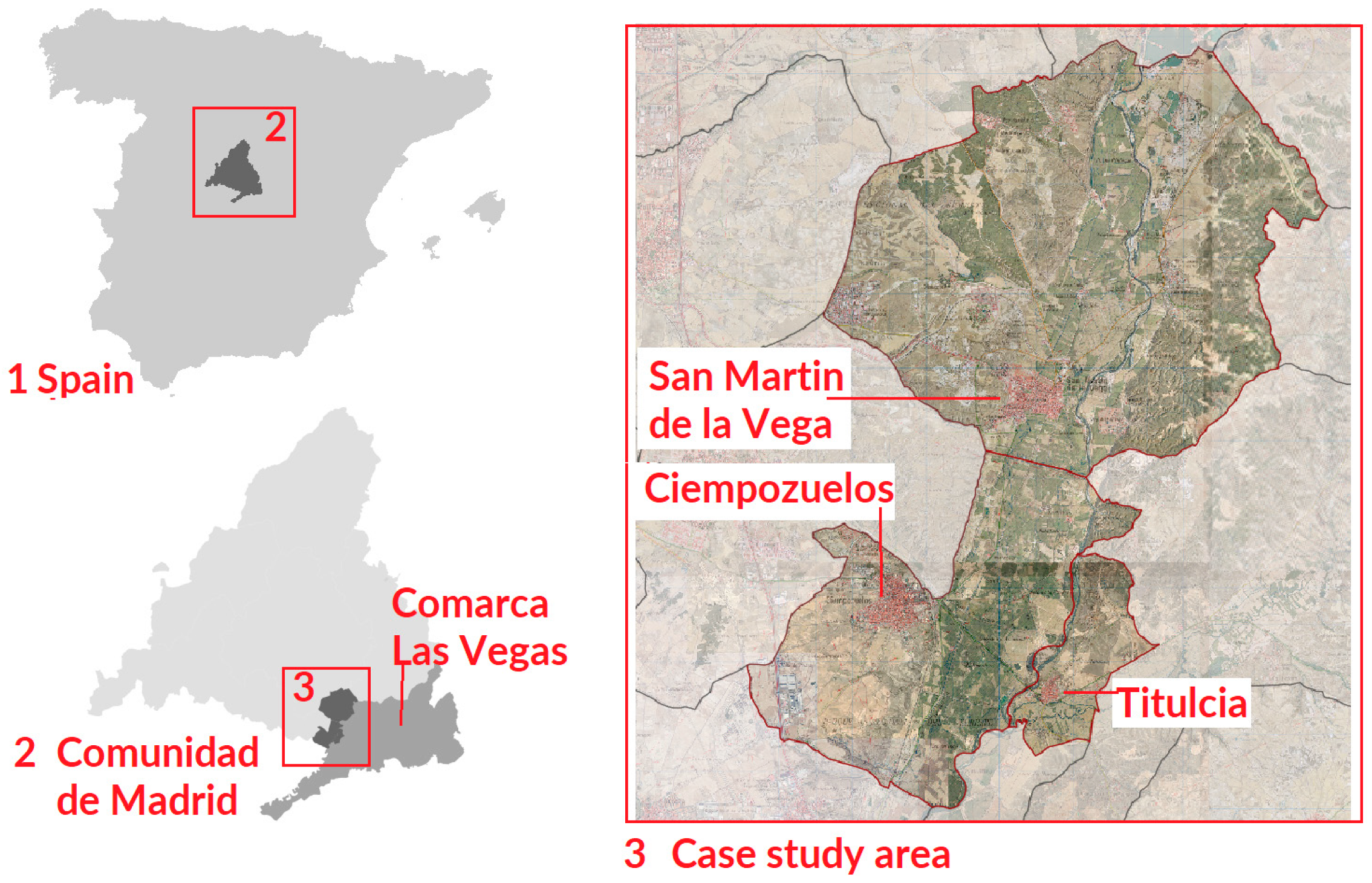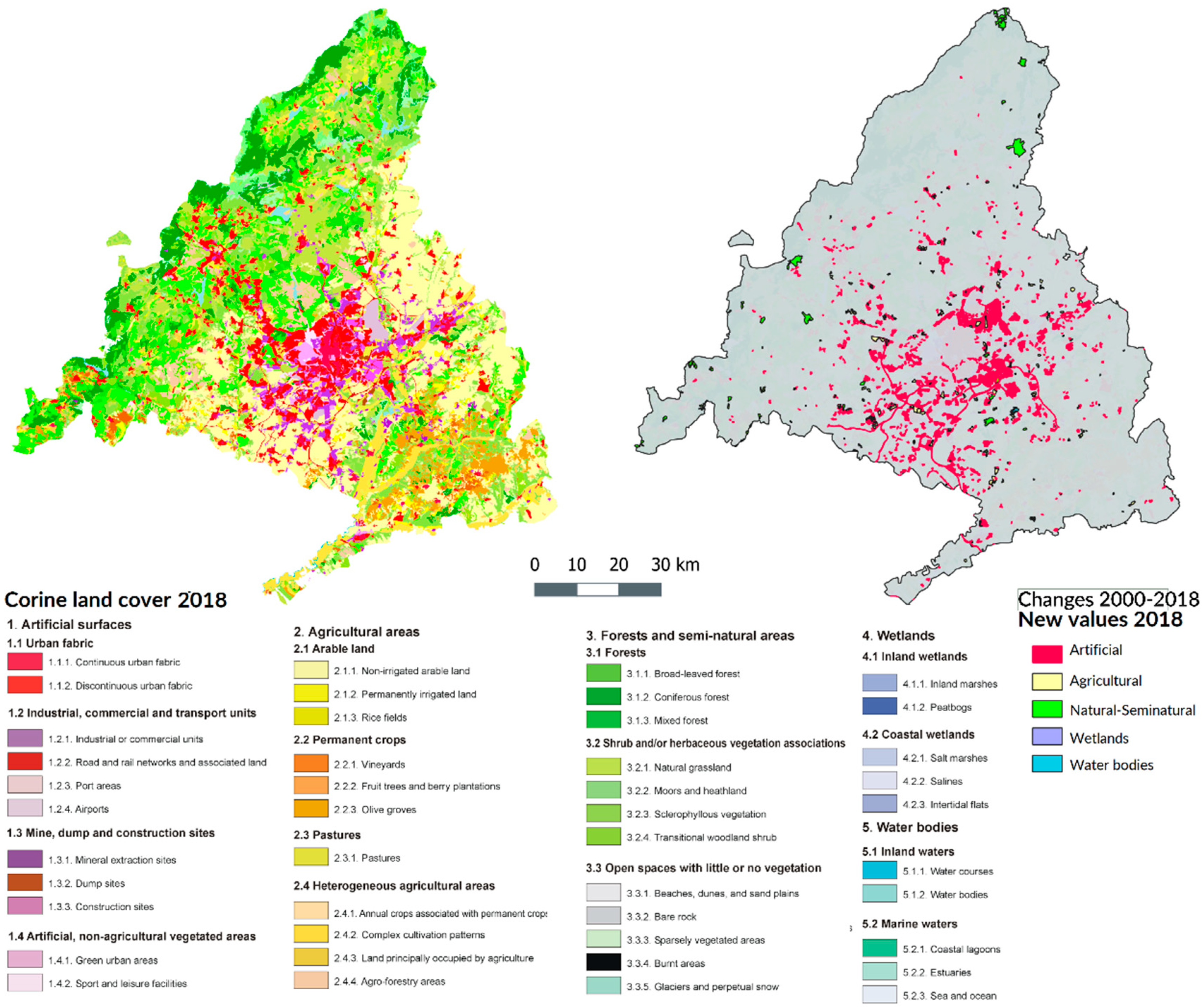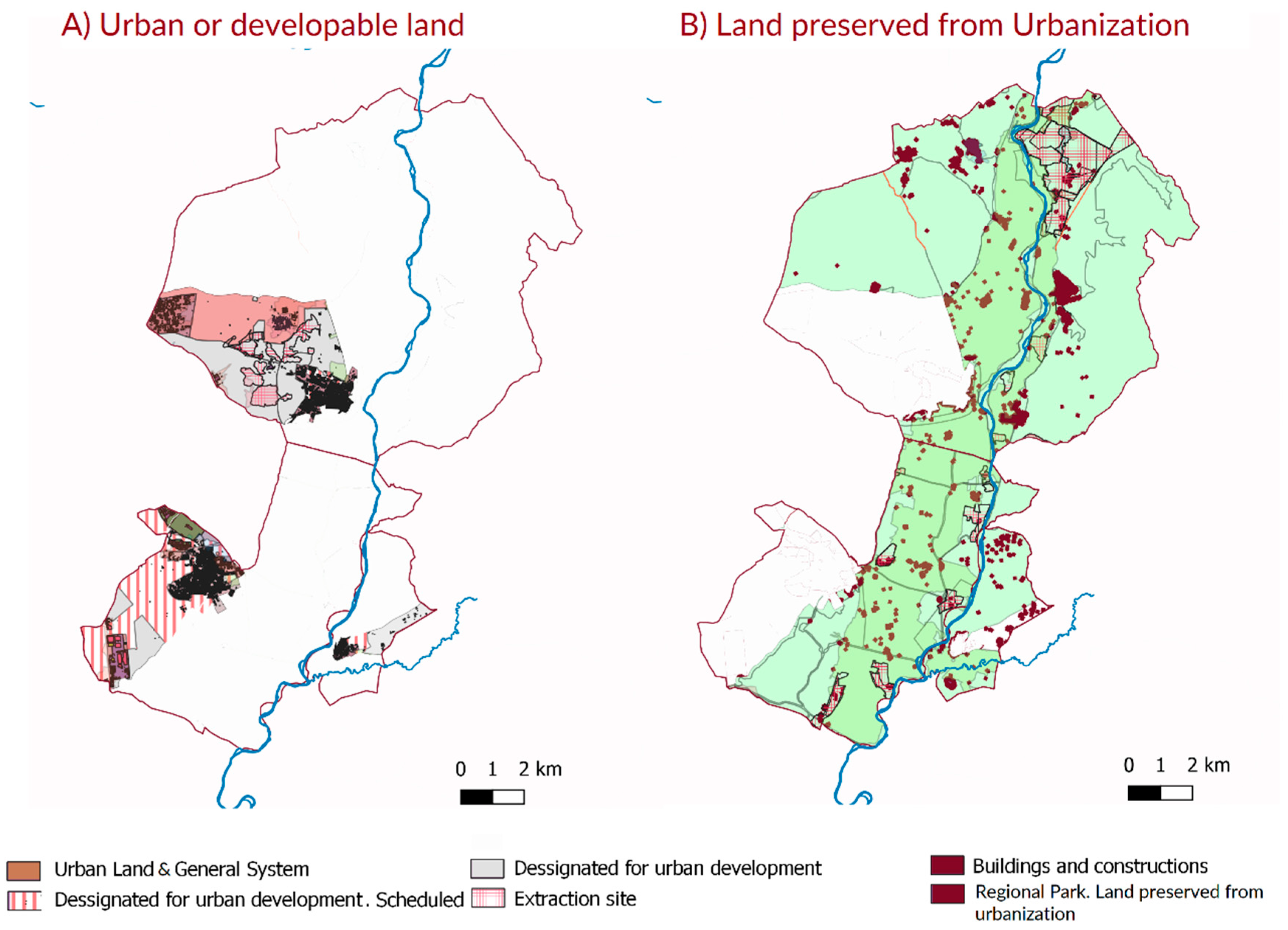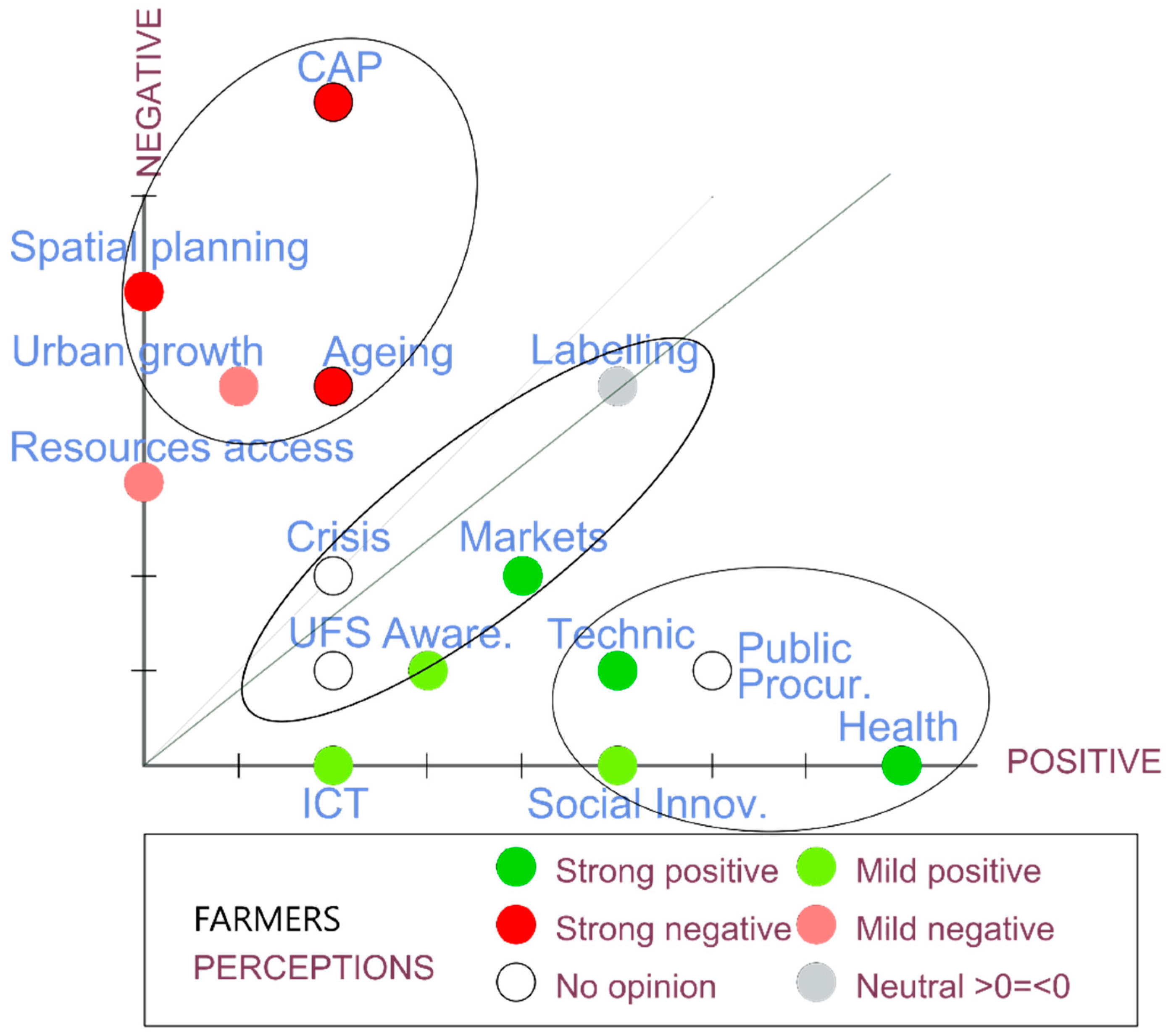Public Food Procurement as a Driving Force for Building Local and Agroecological Food Systems: Farmers’ Skepticism in Vega Baja del Jarama, Madrid (Spain)
Abstract
:1. Introduction
2. Materials and Methods
- changes in land use and farming systems, with special attention to the emergence of new trends, such as agroecology and alternative food networks;
- stakeholder perception of the driving forces for these changes, the importance they assign to global and local drivers and what reaction takes place;
- public procurement’s potential to support local agriculture and if it is part of farmers’ plans.
2.1. Study Area
2.2. Agricultural Land Use and Production and Consumption of Local Food
2.3. Farmers and Stakeholder Perceptions
2.4. Public Food Procurement
3. Results
3.1. Changes in Land Uses, Farming, and Food Marketing
3.2. Stakeholder Perception of Changes in the Agricultural Sector. Drivers, Constraints, and Potentials
3.3. Public Procurement
4. Discussion
4.1. Struggling to Maintain Agriculture
4.2. Building Resilience and an Enabling Environment for Sustainable Food Systems
5. Conclusions
Author Contributions
Funding
Acknowledgments
Conflicts of Interest
References
- Marsden, T.; Franklin, A. Replacing neoliberalism: Theoretical implications of the rise of local food movements. Local Environ. 2013, 18, 636–641. [Google Scholar] [CrossRef]
- Dubbeling, M.; Zeeuw, H.D.; Veenhuizen, R.V. Cities, Poverty and Food: Multi-Stakeholder Policy and Planning in Urban Agriculture; Practical Action Publishing: Rugby, UK, 2010; pp. 1–2. [Google Scholar]
- FAO. The Role of Cities and Local Governments in Responding to the Emergency; Policy Briefing: Rome, Italy, 2020; p. 1. [Google Scholar]
- Tilzey, M. Global Politics, Capitalism, Socio-Ecological Crisis, and Resistance: Exploring the Linkages and the Challenges. In Proceedings of the Colloquium Global Governance/Politics, Climate Justice & Agrarian/Social Justice: Linkages and Challenges, Hague, The Netherlands, 4–5 February 2016; ICAS: Den Haag, The Netherlands, 2016. [Google Scholar]
- A Farm to Fork Strategy for a Fair, Healthy and Environmentally—Friendly Food System. Available online: https://ec.europa.eu/food/farm2fork_en (accessed on 6 July 2020).
- Altieri, M.; Hecht, S.; Liebman, M.; Magdoff, R.; Norgaard, R.; Sikor, T. Agroecología: Bases Científicas Para una Agricultura Sustentable; Centro de Investigación, Educación y Desarrollo: Lima, Peru, 1997; p. 9. [Google Scholar]
- Francis, C.; Lieblein, G.; Gliessman, S.; Breland, T.A.; Creamer, N.; Harwood, R.; Salomonsson, L.; Helenius, J.; Rickerl, D.; Salvador, R. Agroecology: The ecology of food systems. J. Sustain. Agric. 2003, 22, 99–118. [Google Scholar] [CrossRef]
- Gliessman, S. Transforming Food Systems with Agroecology. Agroecol. Sustain. Food Syst. 2016, 40, 187–189. [Google Scholar] [CrossRef]
- Nicholls, C.I.; Altieri, M.A.; Vazquez, L. Agroecology: Principles for the conversion and redesign of farming systems. J. Ecosyst. Ecography S 2016, 5, 2–8. [Google Scholar] [CrossRef]
- Holt-Giménez, E. Food security, food justice, or food sovereignty. In Cultivating Food Justice: Race, Class, and Sustainability; The MIT Press: Cambridge, MA, USA, 2011; pp. 309–330. [Google Scholar]
- Theories and Models of the Peri-Urban Interface: A Changing Conceptual Landscape. Available online: http://citeseerx.ist.psu.edu/viewdoc/download?doi=10.1.1.195.3108&rep=rep1&type=pdf (accessed on 14 July 2020).
- Ávila-Sánchez, H. Socio-territorial changes in peri-urban food production spaces in Central Mexico. Norois Environ. Aménagement Société 2011, 221, 39–51. [Google Scholar] [CrossRef] [Green Version]
- Lohrberg, F.; Lička, L.; Scazzosi, L.; Timpe, A. It is a business! Business models in urban agriculture. In Urban Agriculture Europe; Jovis: Berlin, Germany, 2016; pp. 82–91. [Google Scholar]
- Lohrberg, F.; Lička, L.; Scazzosi, L.; Timpe, A. From urban food gardening to urban farming. In Urban Agriculture Europe; Jovis: Berlin, Germany, 2016; pp. 22–28. [Google Scholar]
- Food & Beverage Retail España. 2018. Available online: https://www.cushmanwakefield.com/es-es/spain/insights/food-beverage-retail-espana-2018 (accessed on 25 January 2020).
- Ilieva, R.T. Urban food systems strategies: A promising tool for implementing the SDGs in practice. Sustainability 2017, 9, 1707. [Google Scholar] [CrossRef] [Green Version]
- Soldi, R. Sustainable Public Procurement of Food; European Union: Brussels, Belgium, 2018; pp. 27–32. [Google Scholar]
- Sonnino, R. Quality food, public procurement, and sustainable development: The school meal revolution in Rome. Environ. Plan. A 2009, 41, 425–440. [Google Scholar] [CrossRef]
- Caldeira, S.; genannt Bonsmann, S.S.; Bakogianni, I.; Gauci, C.; Calleja, A.; Furtado, A. Public Procurement of Food for Health; Publications Office of the EU: Luxembourg, 2017; pp. 10–11. [Google Scholar]
- Debolini, M.; Marraccini, E.; Dubeuf, J.P.; Geijzendorffer, I.R.; Guerra, C.; Simon, M.; Targetti, S.; Napoléone, C. Land and farming system dynamics and their drivers in the Mediterranean Basin. Land Use Policy 2018, 75, 702–710. [Google Scholar] [CrossRef]
- Wiskerke, J.S. On places lost and places regained: Reflections on the alternative food geography and sustainable regional development. Int. Plan. Stud. 2009, 14, 369–387. [Google Scholar] [CrossRef]
- Béné, C.; Prager, S.D.; Achicanoy, H.; Alvarez Toro, P.; Lamotte, L.; Bonilla Cedrez, C.; Mapes, B.R. Understanding food systems drivers: A critical review of the literature. Glob. Food Secur. 2019, 149–159. [Google Scholar] [CrossRef]
- Terres, J.M.; Scacchiafichi, L.N.; Wania, A.; Ambar, M.; Anguiano, E.; Buckwell, A.; Coppola, A.; Gocht, A.; Källström, H.N.; Pointereau, P. Farmland abandonment in Europe: Identification of drivers and indicators, and development of a composite indicator of risk. Land Use Policy 2015, 49, 20–34. [Google Scholar] [CrossRef]
- Sassen, S. Global Networks, Linked Cities; Psychology Press: Oxford, UK, 2002; pp. 124–126. [Google Scholar]
- Programa de Desarrollo Rural de la Comunidad de Madrid 2014–2020. Available online: https://www.comunidad.madrid/sites/default/files/doc/medio-ambiente/cma_agr_anexo_dafo.pdf (accessed on 20 May 2020).
- Estructura de la Industria Alimentaria y las Tendencias del Consumo en la Comunidad de Madrid: Base Para la Realización de Estudios Sectoriales. Available online: https://www.comunidad.madrid/publicacion/ref/9377 (accessed on 3 May 2020).
- Estrategia de Alimentación Saludable y Sostenible, 2018–2020. Available online: https://transparencia.madrid.es/portales/transparencia/es/Organizacion/Planes-y-memorias/Planes/Estrategia-de-Alimentacion-Saludable-y-Sostenible-del-Ayuntamiento-de-Madrid-para-el-periodo-2018-2020/?vgnextfmt=default&vgnextoid=9a270d9894665610VgnVCM1000001d4a900aRCRD&vgnextchannel=d869508929a56510VgnVCM1000008a4a900aRCRD (accessed on 29 May 2020).
- Spanish Urban Agenda. Available online: https://www.aue.gob.es/en/the-spanish-urban-agenda (accessed on 10 May 2020).
- Lardon, S.; Piveteau, V. Méthodologie de diagnostic pour le projet de territoire: Une approche par les modèles spatiaux. Géocarrefour 2005, 80, 75–90. [Google Scholar] [CrossRef] [Green Version]
- La alimentación en la Comunidad de Madrid. Available online: http://www.madrid.org/cs/Satellite?blobcol=urldata&blobheader=application%2Fpdf&blobheadername1=Content-Disposition&blobheadervalue1=filename%3DLa+alimentaci%C3%B3n+en+la+Comunidad+de+Madrid.pdf&blobkey=id&blobtable=MungoBlobs&blobwhere=1352883644096&ssbinary=true (accessed on 22 June 2018).
- Superficies y Producciones Anuales de Cultivos. Available online: https://diario.madrid.es/madridalimenta/wp-content/uploads/sites/36/2018/07/EstrategiaAlimentacion-SS-2018-2020.pdf (accessed on 15 August 2020).
- Memoria 2018 de la Estrategia de Alimentación Saludable y Sostenible. Available online: https://diario.madrid.es/madridalimenta/wp-content/uploads/sites/36/2019/06/MEMORIA_EJECUCION_2019_ESTRATEGIA_ALIMENTACION.pdf (accessed on 1 October 2019).
- Simon-Rojo, M.; Couceiro-Arroyo, A.; Fariña-Tojo, J. La relocalización alimentaria débil: Desconexión entre agentes del territorio y planificación espacial/Weak food relocation: Disconnection between territorial agents and spatial planning. Urbano 2019, 106–123. [Google Scholar]
- Kinnunen, P.; Guillaume, J.H.; Taka, M.; D’Odorico, P.; Siebert, S.; Puma, M.J.; Jalava, M.; Kummu, M. Local food crop production can fulfil demand for less than one-third of the population. Nat. Food 2020, 1, 229–237. [Google Scholar] [CrossRef]
- Gliessman, S. Breaking away from Industrial Food and Farming Systems: Seven Case Studies of Agroecological Transition; International Panel of Experts on Sustainable Food Systems (IPES-Food): Brussels, Belgium, 2018; pp. 94–95. [Google Scholar]
- Landis, D.A. Designing agricultural landscapes for biodiversity-based ecosystem services. Basic Appl. Ecol. 2017, 18, 1–12. [Google Scholar] [CrossRef] [Green Version]
- Opitz, I.; Berges, R.; Piorr, A.; Krikser, T. Contributing to food security in urban areas: Differences between urban agriculture and peri-urban agriculture in the Global North. Agric. Hum. Values 2016, 33, 341–358. [Google Scholar] [CrossRef] [Green Version]
- Wezel, A.; Fleury, P.; David, C.; Mundler, P. The food system approach in agroecology supported by natural and social sciences. In Agroecology, Ecosystems and Sustainability; CRC Press/Taylor and Francis Group: Boca Raton, FL, USA, 2014; pp. 181–199. [Google Scholar]
- Galt, R.E. Placing food systems in first world political ecology: A review and research agenda. Geogr. Compass 2013, 7, 637–658. [Google Scholar] [CrossRef] [Green Version]
- Hinrichs, C.C. Embeddedness and local food systems: Notes on two types of direct agricultural market. J. Rural Stud. 2000, 16, 295–303. [Google Scholar] [CrossRef]
- Ross, N.J. How civic is it? Success stories in locally focused agriculture in Maine. Renew. Agric. Food Syst. 2006, 114–123. [Google Scholar] [CrossRef]
- Maye, D. ‘Smart food city’: Conceptual relations between smart city planning, urban food systems and innovation theory. City Cult. Soc. 2019, 16, 18–24. [Google Scholar] [CrossRef]
- City Regions as Landscapes for People Food and Nature. Available online: https://www.un.org/esa/ffd/wp-content/uploads/sites/2/2015/10/CityRegionsAsLandscapesforPeopleFoodandNature_smallest.pdf (accessed on 10 October 2019).
- World Bank. Benchmarking Public Procurement 2015: Pilot Report Assessing Public Procurement Systems in 10 Economies; World Bank: Washington, DC, USA, 2015; p. 2. [Google Scholar]
- Hajnalka, P.; Gomez, M.; Franchi, V. Strengthening Sector Policies for Better Food Security and Nutrition Results. Public Food Procurement; FAO: Rome, Italy, 2017; p. 10. [Google Scholar]
- Report Presented at the 16th Session of the United Nations Human Rights Council [A/HRC/16/49]. Available online: http://www.srfood.org/images/stories/pdf/officialreports/20140310_finalreport_en.pdf (accessed on 1 October 2019).
- Álvarez Vispo, I.; López, D. Hacia un sistema alimentario sostenible en el Estado Español. AE. Rev. Agroecol. Divulg. 2018, 34, 18–21. [Google Scholar]
- Hambre e Inseguridad Alimentaria en la Comunidad de Madrid. Available online: https://oda-madrid.org/wp-content/uploads/2020/05/InsseguridadAlimentaria_CMadrid2020.pdf (accessed on 13 July 2020).
| 1 | External supply includes inputs from other Spanish’s regions (Comunidades Autónomas). |
| 2 | |
| 3 |




| Economic | Institutional | Social | ||||
|---|---|---|---|---|---|---|
| Farmers | Associations (Unions, Coops) | Consultants | Political-Managers | Researchers | Agroecology Movement | |
| Public policies | ||||||
| Common Agricultural Policy and subsidies | - - | -/+ | - | - | -/+ | - |
| Spatial planning | - | - | ᴓ | - | - | - |
| Urban Food Strategies | ᴓ | ᴓ | + | ᴓ | - | + |
| Public procurement | ᴓ | ᴓ | +/- | + | ++ | ++ |
| Market administration | + | + | - | + | + | - |
| Labeling | - | + | +/- | + | +/- | +/- |
| Access to land/facilities | - | ᴓ | - | ᴓ | ᴓ | - |
| Awareness programs | ᴓ | + | - | + | + | ᴓ |
| Innovation | ||||||
| Production technics | ᴓ | ++ | ᴓ | ᴓ | ++ | +/- |
| Information and Communication Technology (ICT) | + | ᴓ | ᴓ | ᴓ | + | ᴓ |
| Social innovation | + | ᴓ | + | ᴓ | ++ | + |
| Social context | ||||||
| Urban growth | - | ᴓ | ᴓ | +/- | - | - |
| Health/environment interest | + | ++ | + | + | + | ++ |
| Economic Crisis | ᴓ | ᴓ | ᴓ | - | + | +/- |
| Aging Agrarian Sector | - - | -/+ | ᴓ | ᴓ | -/+ | ᴓ |
| Food | Institutional Food Procurement Demand (Tons or Liters) | Production (Tons or Liters) T: Total O: Organic | Ratio Demand/Production T: Total Production; O: Organic Production | ||
|---|---|---|---|---|---|
| 100% Demand | 50% Demand | 20% Demand | |||
| Milk, dairy | 28,382 | T: 82,000 O: 3449 | T: 35% O: 823% | T: 17% O: 411% | T: 7% O: 164% |
| Meat | 17,035 | T: 148,719 O: 57 | T: 12% O: 29,888% | T: 6% O: 14,944% | T: 2% O: 5977% |
| Fruit | 16,620 | T: 923 O: 19 | T: 1800% O: 85,763% | T: 900% O: 42,881% | T: 360% O: 17,152% |
| Potatoes | 14,639 | T: 10,460 O: 17 | T: 140% O: 85,863% | T: 70% O: 42,881% | T: 28% O: 17,152% |
| Vegetables (fresh or processed) | 11,678 | T: 60,832 O: 416 | T: 19% O: 2805% | T: 10% O: 1402% | T: 4% O: 561% |
| Oil | 4448 | T: 32,123 O: 5100 | T: 19% O: 87.2% | T: 7% O: 43.6% | T: 3% O: 17.4% |
| Cereals derivatives | 9607 | T: 297,183 O: 632 | T: 3% O: 1519% | T: 2% O: 760% | T: 1% O: 304% |
| Pulse | 2255 | T: 9202 O: 3 | T: 24% O: 66,924% | T: 12% O: 33,462% | T: 5% O: 13,385% |
| Nuts | 114 | T: 555 O: 15 | T: 20% O: 745% | T: 10% O: 373% | T: 4% O: 149% |
| Honey | 16 | T: 218 O: 18 | T: 7% O: 88% | T: 4% O: 44% | T: 2% O: 18% |
© 2020 by the authors. Licensee MDPI, Basel, Switzerland. This article is an open access article distributed under the terms and conditions of the Creative Commons Attribution (CC BY) license (http://creativecommons.org/licenses/by/4.0/).
Share and Cite
Simón-Rojo, M.; Couceiro, A.; del Valle, J.; Fariña Tojo, J. Public Food Procurement as a Driving Force for Building Local and Agroecological Food Systems: Farmers’ Skepticism in Vega Baja del Jarama, Madrid (Spain). Land 2020, 9, 317. https://doi.org/10.3390/land9090317
Simón-Rojo M, Couceiro A, del Valle J, Fariña Tojo J. Public Food Procurement as a Driving Force for Building Local and Agroecological Food Systems: Farmers’ Skepticism in Vega Baja del Jarama, Madrid (Spain). Land. 2020; 9(9):317. https://doi.org/10.3390/land9090317
Chicago/Turabian StyleSimón-Rojo, Marian, Andrés Couceiro, Julia del Valle, and José Fariña Tojo. 2020. "Public Food Procurement as a Driving Force for Building Local and Agroecological Food Systems: Farmers’ Skepticism in Vega Baja del Jarama, Madrid (Spain)" Land 9, no. 9: 317. https://doi.org/10.3390/land9090317





